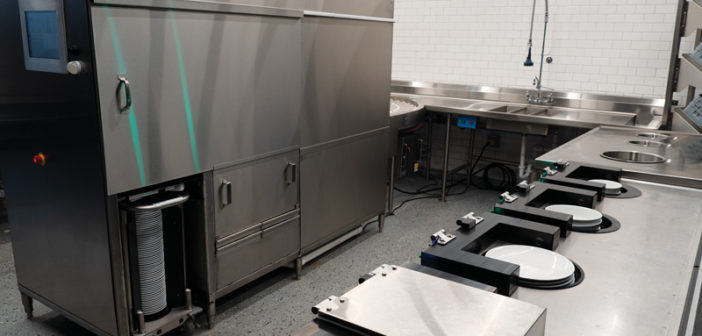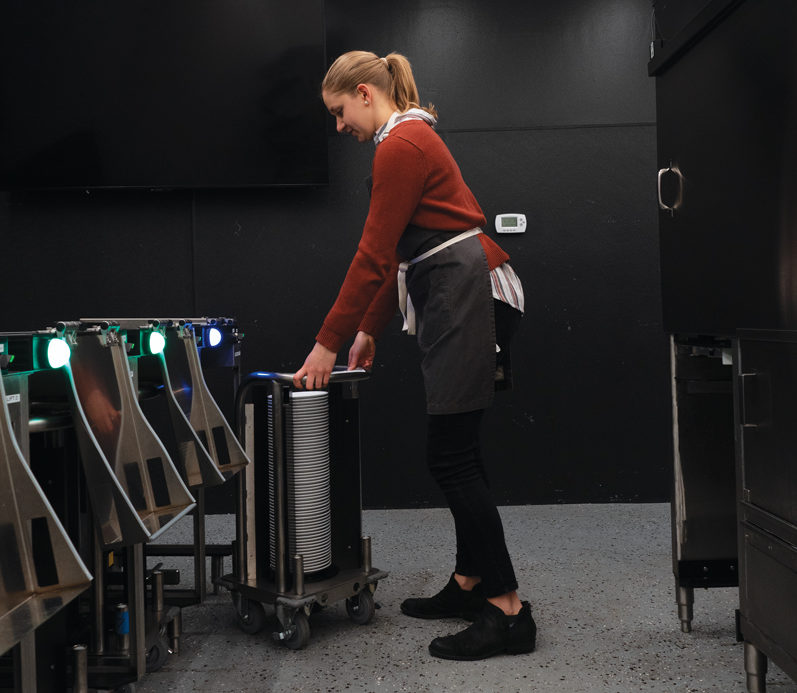SAN FRANCISCO—The job of dishwasher in a commercial kitchen can be one of the most tedious—and backbreaking—ones, causing a great deal of turnover in the position.
Now, Dishcraft has unveiled an automated dishroom using robotics and machine learning to do the work.
“We really wanted to help the commercial kitchen operator have a safer, more reliable system and a better process,” said Linda Pouliot, CEO/co-founder, Dishcraft. “What we found was that the churn [turnover]for dishwashers was every 42 days, and wages were increasing; that just created an untenable situation for the operator. Our pricing was coming down in terms of robotics, so I knew there was an opportunity because the tasks that were being done were repetitive enough that we could actually solve this.”
When dirty dishes come into the kitchen, they are dropped into a cart. “The cart is almost like a cartridge in an inkjet printer where once a cart is full, a light goes off and the dishwasher takes that cart and pushes it into the robot; the robot takes over from there to do the pre-rinse and the racking,” said Pouliot.
Each dish is inspected in a fraction of a second for remaining food residue using computer vision and machine learning. “Each ware is individually inspected and rinsed clean, and then it is racked and pushed automatically into the dish machine for the final sanitization step,” she said. “We are doing the sorting, pre-rinsing and racking that the human labor is doing today.”
Dishcraft handles the front end of the dishwashing and can work with any brand of dish machine or sanitizer. “We are brand agnostic, so if they have Champion or Stero or Hobart, or any brand, we can work alongside any of them,” she said. “We are adding the component in front of it that the human is currently doing.”
Hands-on experience
Pouliot was first approached about finding an automated solution for dishwashing after the first company she founded, Neato Robotics, a consumer robotic vacuum maker, was acquired.
“Someone from the restaurant industry learned about that background and contacted me multiple times and said, ‘Hey, can we meet because I have a problem in the restaurant industry, and I think that you may be able to solve it yourself or introduce me to people who could,’” she said. “He was really struggling to retain staff…and was really worried and wanted to know if robotics could help him solve some of the issues he was finding.”
She was interested and decided that, in order to have a good examination of the problem, she would work in commercial kitchens. “I don’t think you can solve the problem unless you live the life of the operator or the person whose problem you are trying to solve,” said Pouliot. “We’ve always taken the attitude at Dishcraft that everyone here does a stint in a kitchen because not only will they learn about dishwashing and how it can help there, but they will also see what other problems we can take the same technology and apply it to.”
Pouliot received her hands-on experience by calling kitchens in casinos, pubs and university dining halls, and offering herself up to do any task. “I didn’t make it a requirement of being a dishwasher. I was there and I was observing,” she said. “I did a bunch of different tasks. I did bussing, prep work and dishwashing. After having been to enough venues and talking to enough owners and operators, everyone kept coming back to dishwashing being such a pain point—we believed that we could make a difference there.”
Through the hands-on work, she learned a number of things that she knew she needed to include in the system, a main one being sustainability.
“When I was washing dishes, often I would see that a dishwasher would clamp the water to [keep it running constantly]because ergonomically, it is really tough on staff,” she said. “To make their job easier, they would just wind a rubber band around the hose that was used for rinsing, and that wasted so much water, often five gallons per cover. So that was important to us.”
The Dishcraft system recirculates the gray water used for rinsing, and only uses cold water. “We don’t use any chemicals,” said Pouliot. “That is much more sustainable because we use much less water. Because we are only using cold water, we are using much less power.”
The use of less water also lowers the risk of slip-and-fall accidents. “When I was doing the dishes myself, and I was working at many different locations, there were many times where I almost slipped,” she said. “When you are running really quickly around a wet environment, often the floors get really wet and slippery. Subsequently, I found out that 25% of the accidents that happen in a kitchen happen in front of the sink. We really wanted to reduce slips and falls, but we also wanted to reduce the ergonomic strain on kitchen staff. By doing all of this, we would improve the morale of the kitchen because people would just be happier.”
The system also does not use chemicals. “Today, a human dishwasher will often use surfactants when they are rinsing a plate,” she said. “Because our system is closed, we use what is called direct manipulation. We have a unique scrubber that conforms to the shape of every plate and does a very quick cleaning. That direct pressure or friction against the plate does a better job cleaning it than surfactants and a human could do because it is so much more consistent.”
Pouliot also thinks that the system will cut down on the chemical and energy used by the sanitizer. “We don’t push a rack into the sanitizer unless it is completely full, so fewer racks go through,” she said. “The dish machine doesn’t know how full a rack is. It doesn’t have that kind of technology. It dispenses the same amount of chemicals no matter what. We only put a rack through that is full, as opposed to a human who sometimes will only put in one dish, which wastes a lot of water and chemicals.”
The system isn’t necessarily replacing humans in the kitchen, according to Pouliot. Instead, it is doing a job that is hard to fill. “What we’re doing is filling a role; there were already so many openings, so we’re filling a void,” she said. “The way a restaurant operator will describe it to me is that there are so many openings that if a dishwasher isn’t happy, they will simply just walk off because they know they can just walk down the street and be picked up immediately. There is no reason for them to stay at any operation if there is any time they get frustrated. They just simply leave because they know they can get hired within five minutes elsewhere. It is a real problem.”
She continued, “I know that the average tenure of a dishwasher is 42 days. That is from statistics. We have heard anecdotally that it takes five weeks to train a new employee, so if they are gone once they have gotten to the training, then it is just this constant headache of filling the role.”
While the system currently has the same throughput as a human worker, in the future, the company hopes it will be twice as fast. “We are definitely trying to save the operator money, so right now, it is about 20% savings for customers,” Pouliot said. “ Primarily, it is because of the savings in labor, but there are other things. It is also the savings in power, water, safety/workers comp issues and less breakage of the wares.” HB



